
The Doric Transistorized Organ is a model of combo organ produced in Italy in the 1960s. [1]

The Doric Transistorized Organ is a model of combo organ produced in Italy in the 1960s. [1]
Doric organs were also sold under the brand name Ekosonic and were marketed as being the "lightest on the market" at 30 pounds (14 kg). [2] [3] Much like early Farfisa combo organs, Doric organs featured a monophonic bass section and a polyphonic lead which emulated other instruments by using transistor oscillators and a frequency divider section. The Doric never achieved the same fame as Farfisa and Vox organs, perhaps due to limited distribution and a lower price point.
The Doric 61TT featured controls activating
The control for stops operates like a pipe organ, in a push-pull manner, activating 4', 8', and 16' stops.
Although the Doric organs sold in the United States operated on standard 120 V power, the cable connecting the unit to a wall was unique, and, as a result, many organs are sold without plugs and users are forced to either replace the jack with an IEC standard, fashion a plug from appliance cords, or buy expensive vintage cables. The power supply that the jack connects to converts household current to 9 V DC.
Inside the Doric is a line of circuits labeled with the syllables of solfege, each generating a given tone in a scale. At the far left is a single circuit for the bass notes which shares a circuit board with the solid-state vibrato mechanism. As with many organs of the same vintage, Doric organs often have problems with electrolytic capacitors which overflow or burn out over time.

The Hammond organ is an electric organ invented by Laurens Hammond and John M. Hanert and first manufactured in 1935. Multiple models have been produced, most of which use sliding drawbars to vary sounds. Until 1975, Hammond organs generated sound by creating an electric current from rotating a metal tonewheel near an electromagnetic pickup, and then strengthening the signal with an amplifier to drive a speaker cabinet. The organ is commonly used with the Leslie speaker.
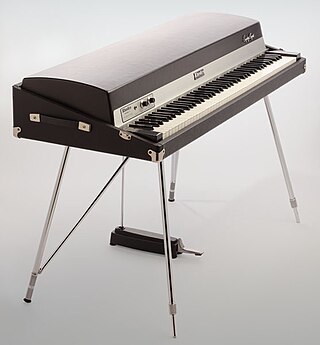
The Rhodes piano is an electric piano invented by Harold Rhodes, which became popular in the 1970s. Like a conventional piano, the Rhodes generates sound with keys and hammers, but instead of strings, the hammers strike thin metal tines, which vibrate next to an electromagnetic pickup. The signal is then sent through a cable to an external keyboard amplifier and speaker.

Vox is a British musical equipment manufacturer founded in 1957 by Thomas Walter Jennings in Dartford, Kent, England. The company is most famous for making the Vox AC30 guitar amplifier, used by The Beatles, The Rolling Stones, The Kinks, The Yardbirds, Queen, Dire Straits, U2, and Radiohead; the Vox Continental electric organ, the Vox wah-wah pedal used by Jimi Hendrix, and a series of innovative electric guitars and bass guitars. Since 1992, Vox has been owned by the Japanese electronics firm Korg.
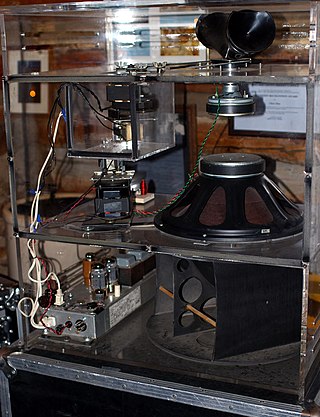
The Leslie speaker is a combined amplifier and loudspeaker that projects the signal from an electric or electronic instrument and modifies the sound by rotating a baffle chamber ("drum") in front of the loudspeakers. A similar effect is provided by a rotating system of horns in front of the treble driver. It is most commonly associated with the Hammond organ, though it was later used for the electric guitar and other instruments. A typical Leslie speaker contains an amplifier, a treble horn and a bass speaker—though specific components depend upon the model. A musician controls the Leslie speaker by either an external switch or pedal that alternates between a slow and fast speed setting, known as "chorale" and "tremolo".

A guitar amplifier is an electronic device or system that strengthens the electrical signal from a pickup on an electric guitar, bass guitar, or acoustic guitar so that it can produce sound through one or more loudspeakers, which are typically housed in a wooden cabinet. A guitar amplifier may be a standalone wood or metal cabinet that contains only the power amplifier circuits, requiring the use of a separate speaker cabinet–or it may be a combo amplifier, which contains both the amplifier and one or more speakers in a wooden cabinet. There is a wide range of sizes and power ratings for guitar amplifiers, from small, lightweight practice amplifiers with a single 6-inch speaker and a 10-watt amp to heavy combo amps with four 10-inch or four 12-inch speakers and a 100-watt amplifier, which are loud enough to use in a nightclub or bar performance.
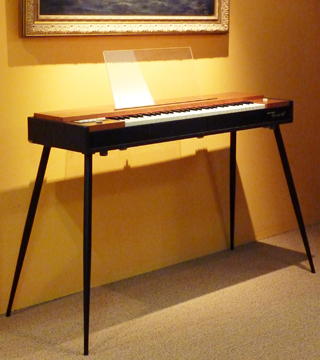
The Clavinet is an electric clavichord invented by Ernst Zacharias and manufactured by the Hohner company of Trossingen, West Germany, from 1964 to 1982. The instrument produces sounds with rubber pads, each matching one of the keys and responding to a keystroke by striking a given point on a tensioned string, and was designed to resemble the Renaissance-era clavichord.
Farfisa is a manufacturer of electronics based in Osimo, Italy, founded in 1946. The company manufactured a series of compact electronic organs in the 1960s and 1970s, including the Compact, FAST, Professional and VIP ranges, and later, a series of other keyboard instruments. They were used by a number of popular musicians, including Sam the Sham, Country Joe and the Fish, Pink Floyd, Sly Stone, Blondie, Suicide and the B-52s.

The Hohner Pianet is a type of electro-mechanical piano built by the Hohner company of Trossingen, West Germany and designed by Ernst Zacharias. The Pianet was a variant of his earlier reed-based Hohner electric piano, the Cembalet, which, like the Pianet, was intended for home use. Hohner offered both keyboards in their range until 1968. The Pianet production consisted of two distinctly different mechanism groups with characteristically different sound. The first group, lasting from introduction to 1977, had ground stainless steel reeds, a pick-up using variable capacitance, and leather-faced activation pads. The second group from 1977 until the end of production used rolled spring-steel reeds, electro-magnetic pick-ups, and moulded silicone rubber activation pads.

Guitar Organ or GuitOrgan is a type of electric guitar with electronic organ components added, developed by Jennings Musical Industry as Vox Guitar Organ at latest in 1965. Similar instrument, GuitOrgan was developed by Murrell Electronics, circa 1967. On this type of instruments, each guitar fret is separated into six segments, creating independent contact switches for each string. The organ notes are keyed when a string touches a specific segment. An expression pedal is used to fade the organ sound in and out, while the guitar can be played at the same time.

Bass pedals are an electronic musical instrument with a foot-operated pedal keyboard with a range of one or more octaves. The earliest bass pedals from the 1970s consisted of a pedalboard and analog synthesizer tone generation circuitry packaged together as a unit. The bass pedals are plugged into a bass amplifier or PA system so that their sound can be heard. Since the 1990s, bass pedals are usually MIDI controllers, which have to be connected to a MIDI-compatible computer, electronic synthesizer keyboard, or synth module to produce musical tones. Some 2010s-era bass pedals have both an onboard synth module and a MIDI output.
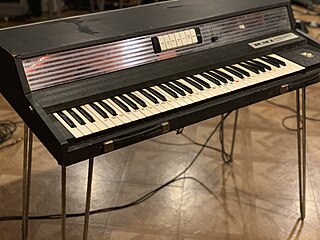
Rocky Mount Instruments (RMI) was a subsidiary of the Allen Organ Company, based in Rocky Mount, North Carolina, active from 1966 to 1982. The company was formed to produce portable musical instruments, and manufactured several electronic pianos, harpsichords, and organs that used oscillators to create sound, instead of mechanical components like an electric piano.

The Wurlitzer electronic piano is an electric piano manufactured and marketed by Wurlitzer from 1954 to 1983. Sound is generated by striking a metal reed with a hammer, which induces an electric current in a pickup. It is conceptually similar to the Rhodes piano, though the sound is different.

The Fender Contempo Organ is a combo organ made by Fender during the late 1960s. It was designed to compete with similar instruments such as the Vox Continental and Farfisa Compact, and had additional stops, features and controllers not found on the other models. However, it was only in production for a few years as it struggled to compete with the more popular Hammond organ and Rhodes piano.

The Vox Continental is a transistorised combo organ that was manufactured between 1962 and 1971 by the British musical equipment manufacturer Vox. It was designed for touring musicians and as an alternative to the heavy Hammond organ. It supports drawbars in a similar manner to the Hammond, and has distinctive reverse-coloured keys. The sound is generated by a series of oscillators, using a frequency divider to span multiple octaves.
A combo organ, so-named and classified by popular culture due to its original intended use by small, touring jazz, pop and dance groups known as "combo bands", as well as some models having "Combo" as part of their brand or model names, is an electronic organ of the frequency divider type, generally produced between the early 1960s and the late 1970s. This type of organ predated, and contributed largely to, the development of modern synthesizers. The combo organ concept, at least in the context of mass-production, is thought to have arisen from popular demand, when smaller home organs were seen in music stores. Combo organs were probably originally developed in the United Kingdom, based on the Univox polyphonic version of the Clavioline, and some models included the inner-workings of Italian-made transistor accordions. They were the brainchild of necessity for portable organs of simple design, mainly for use in these small groups. Combo organs ended up having a major impact on the music scene of the mid- and late 1960s, particularly on rock and roll of that era.

The Gibson G-101 is a transistorised combo organ, manufactured in the late 1960s by the Lowrey Organ Company for Gibson.
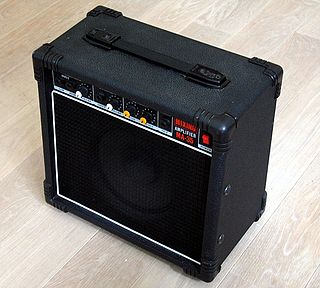
A keyboard amplifier is a powered electronic amplifier and loudspeaker in a speaker cabinet used for the amplification of electronic keyboard instruments. Keyboard amplifiers are distinct from other types of amplification systems such as guitar amplifiers due to the particular challenges associated with making keyboards sound louder on stage; namely, to provide solid low-frequency sound reproduction for the deep basslines that keyboards can play and crisp high-frequency sound for the high-register notes. Another difference between keyboard amplifiers and guitar/bass amplifiers is that keyboard amps are usually designed with a relatively flat frequency response and low distortion. In contrast, many guitar and bass amp designers purposely make their amplifiers modify the frequency response, typically to "roll-off" very high frequencies, and most rock and blues guitar amps, and since the 1980s and 1990s, even many bass amps are designed to add distortion or overdrive to the instrument tone.
The Korg CX-3 is an electronic clonewheel organ with drawbars that simulates the sound of an electromechanical Hammond organ and the Leslie speaker, a rotating speaker effect unit. The CX-3 was first introduced in 1979.
The history of home keyboards lies in mechanical musical instrument keyboards, electrified keyboards and 1960s and 1970s synthesizer technologies.

A digital accordion is an electronic musical instrument that uses the control features of a traditional accordion to trigger a digital sound module that produces synthesized or digitally sampled accordion sounds or, in most instruments, a range of non-accordion sounds, such as orchestral instruments, pipe organ, piano, guitar, and so on. Digital accordions typically encode and transmit key presses and other input as Musical Instrument Digital Interface (MIDI) messages. Most digital accordions need to be plugged into a keyboard amplifier or PA system to hear their sounds.
Citations
Sources